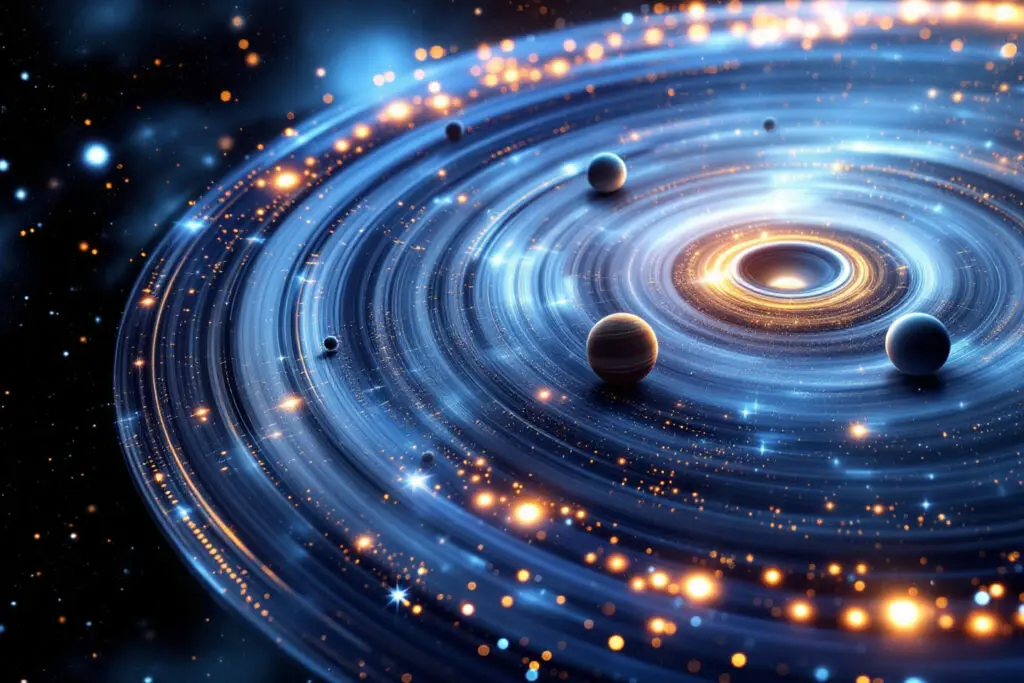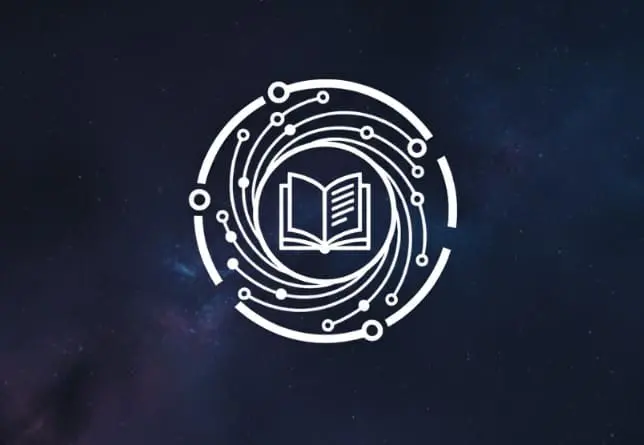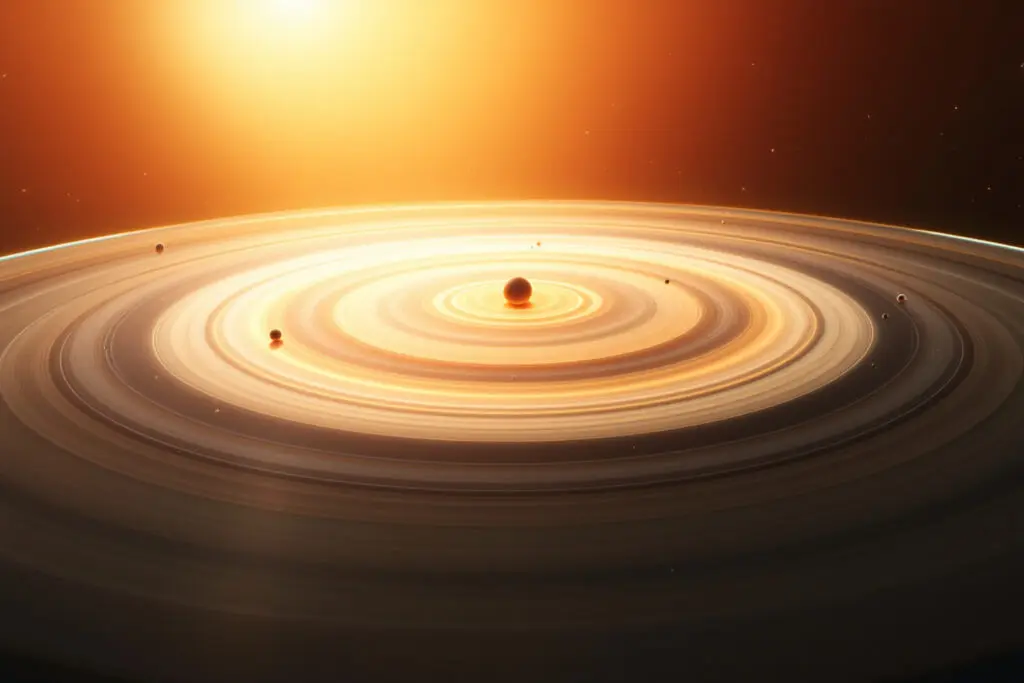Ever go outside on a clear night, look up, and draw an imaginary line between the moon and a super-bright planet like Jupiter? If you have, you’ve stumbled upon one of the coolest and most orderly secrets of our solar system. You might notice the planets aren’t just thrown up there at random. They follow a specific, invisible highway through the stars, a road shared by the Sun and the Moon. This celestial superhighway has a name: the ecliptic. It’s why you’ll never find Mars hanging out by the Big Dipper. But that begs a big question: why do planets follow the ecliptic?
The answer isn’t just a cosmic coincidence.
It’s a story of gravity, motion, and the fiery birth of our solar system. Getting a handle on this path changes stargazing from just looking up to truly understanding the beautiful cosmic mechanics at play in our neighborhood. That neat line of planets is a direct echo of our shared origin story, a reminder of a chaotic but ultimately structured beginning some 4.6 billion years ago.
More in The Observer’s Sky Category
How to Use the Celestial Sphere
Why an Equinox Happens Twice a Year
Key Takeaways
- The Ecliptic in a Nutshell: This is the path the Sun appears to take across our sky over a year. It’s really just the plane of Earth’s orbit, thrown up against the backdrop of stars.
- A Flat System: All the planets in our solar system orbit the Sun on pretty much the same flat plane. Picture a spinning record with the Sun in the middle; the planetary orbits are the grooves.
- It Started with a Spin: This flat layout is a direct leftover from how our solar system formed. It all began as a huge, spinning cloud of gas and dust that flattened into a “protoplanetary disk” thanks to the conservation of angular momentum.
- Our Point of View: Since we’re on Earth, looking out into this flat system, the other planets seem to follow the same narrow track as the Sun. That’s why planets follow the ecliptic.
- Not a Perfect Line: While they stick close to the path, planetary orbits aren’t perfectly aligned. They have small tilts, or “inclinations,” so they sometimes wander slightly above or below the ecliptic.
So, What Exactly Is This “Ecliptic” I Keep Hearing About?
Before we dig into why the planets are stuck on this celestial road, let’s get a better feel for the road itself. “Ecliptic” might sound a bit technical, but the idea behind it is pretty straightforward. It all comes down to our point of view from here on Earth.
Is it just the Sun’s highway across the sky?
That’s a perfect way to put it. Imagine watching the sky for a whole year. You’d see the Sun rise and set daily, of course, but you’d also notice its position at high noon drifting against the distant stars. If you marked its spot every single day and connected the dots, you’d draw a huge circle across the sky. That circle is the ecliptic.
Essentially, it represents the plane of Earth’s orbit around the Sun. Because we live inside this orbital plane, we see it as a line the Sun carves through the constellations. This path was so important to ancient sky-watchers, like the Babylonians and Greeks, that they based their entire zodiac on the 12 constellations the Sun passes through on its yearly journey. So when your horoscope says you’re a Leo, it just means the Sun was visiting the constellation Leo when you were born.
Why the name “ecliptic,” though?
The name itself gives away another one of its big secrets. It’s called the ecliptic because it’s the zone where eclipses happen. For a solar or lunar eclipse to occur, the Sun, Moon, and Earth need to line up just right.
The Moon orbits the Earth on a path that’s tilted by about 5 degrees from the ecliptic plane. This means most months, the Moon’s shadow misses us, or we miss the Moon with our shadow. But there are two points where the Moon’s orbital path crosses the ecliptic. When a new or full moon happens right as the Moon is near one of those crossing points, everything lines up. Bam. An eclipse. The name is a great reminder of that celestial geometry.
Why Don’t Planets Just Roam Anywhere They Want?
Here we get to the real heart of it. We get the road, but why does all the traffic follow it? You’d think there would be planets all over the place, zipping around the Sun from every direction imaginable—top, bottom, and every wild angle in between. But they don’t. They all orbit in the same direction, on the same flat plane. This amazing order is no accident; it’s a direct consequence of how planets are born.
Did something force them into this single file line?
You bet. That “something” was the creation of the solar system itself. Our story starts about 4.6 billion years ago with a massive, cold, shapeless cloud of gas and dust—a solar nebula. It was unimaginably huge. For a long time, it just drifted. Then something—maybe a shockwave from an exploding star—gave it a little push.
That push kicked off a process of gravitational collapse. As the cloud pulled itself inward, it started to spin. This is where a key bit of physics, the conservation of angular momentum, takes over. It’s the same thing a figure skater does. When she pulls her arms in tight, she spins way faster. As the nebula pulled its mass toward the center, its rotation ramped up, and this spin flattened the puffy cloud into a huge, spinning pancake of material. We call this the protoplanetary disk.
How did a giant dust cloud turn into a planetary superhighway?
Inside this spinning disk, the stage was set for planets to form. Almost all the material—over 99.8% of it—fell to the center, getting so hot and dense that it burst into nuclear fusion. And so, our Sun was born. The leftover scraps in the disk didn’t go to waste; they became the planets.
This building process is called accretion. It was a messy, chaotic construction project.
- First, dust bunnies: Tiny grains of dust, coated in ice, started clumping together, kind of like the dust bunnies that form under your bed.
- Then, building blocks: Over millions of years, these clumps grew into pebbles, then boulders.
- Cosmic snowballs: Once big enough to have a real gravitational pull, these objects, called planetesimals, started hoovering up all the material in their path.
- The winners emerge: The planetesimals crashed into each other and merged. The biggest ones grew the fastest, eventually clearing out their orbits and becoming the planets we know today.
The key is that this all happened inside that flat, spinning disk. The planets were built right there on that cosmic turntable. They never had a chance to go anywhere else. They were born in the ecliptic plane, and that’s where they’ve stayed.
But Are the Planets Perfectly Aligned?
Okay, so the planets were all born in a flat disk. Does that mean the solar system is perfectly flat? Or are there some wobbles in the system? If you go look, you’ll see they are almost in a perfect line, but not quite. There’s a little wiggle room.
Do planets ever stray from the path?
They do, but only by a little bit. Each planet’s orbit is tilted slightly compared to ours. Astronomers call this the orbital inclination. If every planet had an inclination of 0 degrees, they’d all follow the exact same line. But they don’t.
Think of it like setting a dinner plate on a table. That plate is the ecliptic. Now, put a slightly smaller plate inside it, but tilt it just a hair. That’s another planet’s orbit. They’re nearly flat with each other, but not quite. Venus has a tilt of about 3.4 degrees, and Saturn is tilted by 2.5 degrees. This is why when you spot planets, they’re always near the ecliptic, but might be a little bit above or below the Sun’s direct path.
Which planet is the biggest rule-breaker?
Of the main eight planets, Mercury is the wild child. Its orbit is tilted by a full 7 degrees. That’s a pretty big tilt, probably because of a massive gravitational shove from Jupiter billions of years ago. This high inclination makes Mercury a little trickier to spot, as it can pop up further from the Sun’s path than the others.
The true outliers, though, are the dwarf planets way out in the boonies of the solar system. Pluto’s orbit is tilted by a wild 17 degrees, meaning it spends most of its time way above or below the main planetary action. The dwarf planet Eris is even crazier, with a tilt of 44 degrees! It’s a great reminder that while the inner solar system is nice and orderly, the outer edges can be a bit of a chaotic mess, likely due to gravitational wrestling matches long ago.
How Can I Actually See This Celestial Highway for Myself?
This is the fun part. You don’t need a massive telescope to see this cosmic order for yourself. The ecliptic is right there in the sky every day and night. Once you know what to look for, you’ll see the sky in a whole new way. It’s a simple observation that connects you to the grand layout of our solar system.
What am I looking for in the night sky?
Finding the ecliptic is surprisingly easy. Your best guide is the Moon. Since its orbit is only tilted by 5 degrees, it’s always hanging out right near the path. On any night, find the Moon, then scan the sky for any bright “stars” that seem to fall in a rough line with it. Good chance those aren’t stars at all, but planets.
You can trace that imaginary arc connecting them across the sky. That’s it. That’s the ecliptic. Another good trick is to pay attention to the path the Sun takes during the day. After sunset, that same path is the one the planets will follow. It generally arcs across the southern part of the sky if you’re in the Northern Hemisphere.
Are there any tools that can help me?
Of course. Modern tech makes this a piece of cake. There are tons of great stargazing apps for your phone, many of them free. Apps like Stellarium, SkyView, or Star Walk let you just point your phone at the sky and will tell you what you’re looking at.
Even better, these apps usually have a setting to display the ecliptic line. Turn that on, hold up your phone, and you’ll see the celestial highway drawn right onto the sky in front of you. You’ll see immediately how the Moon and planets are all lined up along it. It’s a cool “aha!” moment that makes the whole concept click.
What Does This Shared Plane Tell Us About Our Solar System’s History?
The fact that all the planets follow this same road is more than just neat trivia. It’s the bedrock evidence for our entire theory of how the solar system came to be. It’s a story of order being born from chaos.
Is the ecliptic like a fossil of our cosmic birth?
That’s the perfect way to describe it. The flatness of our solar system is a fossil—a leftover imprint of the protoplanetary disk. If the Sun had just grabbed planets as they flew by randomly, our solar system would be a chaotic mess, with orbits going in every direction.
But that’s not what we have. We have a system with a profound, shared history. Every planet, from Mercury to Neptune, orbits in the same direction on nearly the same plane. This is the smoking gun that tells us they all formed together, from one spinning structure. The ecliptic plane you see in the sky tonight is the ghost of that ancient disk, a quiet testament to where we all came from.
Does this mean other solar systems are flat too?
For the longest time, we could only guess. But now, with incredibly powerful telescopes, we can see it happening elsewhere. We can look at young stars and see them surrounded by the same kinds of protoplanetary disks that formed our own system.
Observatories like ALMA in Chile have taken stunning pictures of these disks, showing dark rings and gaps where new planets are clearing out their paths. As NASA’s exoplanet missions have shown time and again, we are literally watching other solar systems being born, and they look a lot like ours must have. It confirms that this flattening process isn’t a fluke. It’s the standard way the universe builds planets. The ecliptic, it turns out, is something of a universal blueprint.
The Highway in the Stars
From a simple line of lights in the sky to the mechanics of creation, the story of the ecliptic is our story. It’s a tale of gravity and momentum, a 4.6-billion-year-old mystery that was solved by a simple spinning cloud of dust. The planets follow the ecliptic because they have to. They were born from the same spinning disk, are bound by the same laws of physics, and are fated to travel the same cosmic road for as long as the solar system exists.
The next time you’re outside, find that path. Trace it from one horizon to the other. You aren’t just looking at a random collection of lights. You are seeing the plane of your home system, the fossil of your cosmic birth. You’re looking at home.
FAQ – Why Do Planets Follow the Ecliptic

What does the alignment of the planets along the ecliptic reveal about the history of our solar system?
The planets orbiting along the same plane serve as evidence that they all formed from the same rotating disk of gas and dust, illustrating the solar system’s origin from a chaotic but ultimately ordered protoplanetary disk, which is a universal pattern observed in other young star systems.
How can I observe the ecliptic in the night sky?
You can observe the ecliptic in the night sky by noting the Moon and planets, which tend to follow a line close to the Sun’s apparent path, especially after sunset, and modern star-gazing apps can help you visualize this celestial highway.
Are the planetary orbits perfectly aligned or do they vary?
While most planetary orbits are very close to the same plane, they are not perfectly aligned; each has a slight tilt or inclination relative to the ecliptic, which varies among planets and contributes to the slight deviations we observe in their paths.
What exactly is the ecliptic and why is it important?
The ecliptic is the apparent path of the Sun across the sky over a year, representing the plane of Earth’s orbit around the Sun, and it is important because it is the basis for the zodiac and the path along which planets and eclipses occur.
Why do all the planets in our solar system orbit on the same flat plane?
All the planets in our solar system orbit on the same flat plane because they formed from a spinning protoplanetary disk of gas and dust around the early Sun, with the conservation of angular momentum causing this flat, structured layout.

